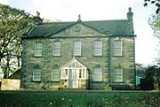
National Museum of Rural Life
Encyclopedia
National Museums Scotland and partners have developed the National Museum of Rural Life, previously known as the Museum of Scottish Country Life, which is based at Wester Kittochside farm, lying between the town of East Kilbride
in South Lanarkshire
and the village of Carmunnock
in Glasgow
.
, the Heritage Lottery Fund
, the European Regional Development Fund
, South Lanarkshire Council, Scottish Natural Heritage
and a number of private funders.
The National Museum of Rural Life has greatly extended the work of the former Scottish Agricultural Museum, founded in 1949, latterly located within the Royal Highland Showground
at Ingliston
, west of Edinburgh
.
The completed National Museum of Rural Life features a 50000 square feet (4,645.2 m²) museum and visitor centre, the Georgian
buildings of Wester Kittochside farm, the species-rich fields and hedgerows around it and a 24 ha (60 acre) events area.
Originally, John Reid, previously the tenant, had purchased the lands of Kittochside in 1567 from the Robert Muir, Laird of Caldwell. Muir tried to take back the lands by force and after burning down Kittochside the case came to be adjudicated at the Privy Council of James VI in 1600, the result being that Robert Muir was jailed for six years and then the Reids were free to develop the farm buildings and lands.
During the covenanting troubles the Reids were prominent and they fought against the king at the Battle of Bothwell Brig in 1679. At one point in the battle the Kilbryd (Kilbride) Parish Flag was taken by the enemy and James Reid fought his way to its rescue, ripping it off its pole and wrapping it around his body as he ran with it. He was captured and would have been sent abroad as a convict if it were not for the intervention of the Duke of Hamilton. James was jailed for a time and then returned in less violent times to manage Wester Kittochside farm.
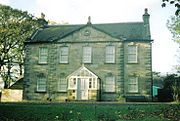 The fine Georgian dwelling house was built in 1782-4 and cost £45.12.7, not an inconsiderable sum for the time, paying for a Laird's home of almost miniature classical country house appearance. An extension to the house was built in 1906 allowing for remodelling of the interior layout. Electricity was installed in the 1920s, replacing the use of oil lamps and candles. The interior of the house has been left as it was in the 1950s.
The fine Georgian dwelling house was built in 1782-4 and cost £45.12.7, not an inconsiderable sum for the time, paying for a Laird's home of almost miniature classical country house appearance. An extension to the house was built in 1906 allowing for remodelling of the interior layout. Electricity was installed in the 1920s, replacing the use of oil lamps and candles. The interior of the house has been left as it was in the 1950s.
Some of the buildings have carved ball finial
s on the gable ends as per the architectural fashion of the time. The finial can also function as a lightning rod
, and was once believed to act as a deterrent to witches
on broomsticks attempting to land on one's roof. On making her final landing approach to a roof, the witch, spotting the obstructing finial, was forced to sheer off and land elsewhere.
Both the house and the farm stand on an exposed hill top and are screened from the elements by mature trees, a particularly fine old Sycamore or Plane
(Acer pseudoplatanus) being prominent amongst them.
. The small byre was re-roofed and upgraded in the mid 19th and early 20th centuries. The corn barn still has its threshing
floor where a flail
would have been used by hand until a horse-engine and threshing machine was installed in around 1820 to 1840. This was in turn replaced in 1860 by the present threshing mill. Finally around 1870 travelling mills made even this mill redundant.
The 6th Laird was involved in quarrying and limestone-burning, hence the need for a stable with room for three horses and loose box, with a loft above. Various modifications took place over the years and a Dutch barn was built in 1949. Dairying ceased in 1980 and the farm turned to raising beef cattle until 1992 when the National Trust for Scotland took over the running of the farm operations.
 The very rare survival of a 'Horse mill
The very rare survival of a 'Horse mill
' , engine or 'gin' at Wester Kittochside has been professionally excavated and restored to working condition. It had been used to drive farm machinery, such as the winnowing machine in the corn barn which removes the husk from grain, powered via a rotating horizontal axle drive from the gin. As already stated, prior to using horse driven machines a flail
was used by the farm workers to separate the grain from the husk. The flail itself being a wood pole with a smaller pole linked at the end via a chain or leather thong. Another door opposite the existing barn door used to provide sufficient wind to separate the grain from the chaff or seed husks.
. The example at Wester Kittochside was used as a tack room in the early 20th century, but came back into use during the Second World War when it was used as quarters for a German prisoner of war, Heinrich Luckel, who remained in contact with the Reid family for many years after the end of the conflict.
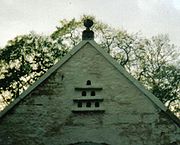 A typical dovecot
A typical dovecot
or doocot is located above the door of the cart shed building. The doocot is a typical feature of country estates, as the right to build one was strictly limited to the major landowners initially, and only later were small freeholders permitted to build them; at a more recent date tenants could sometimes gain permission from their landlord to build doocots to provide food or to add a picturesque feature to their properties. (Peters 2003). In the Middle Ages doocots or pigeon-houses were a badge of manorial privilege and distinctive, often very ornate buildings were constructed (Buxbaum 1987). The Kittochside doocot is a simple and practical design, however the problem of the pigeons feeding off the farm crops still had to be balanced against the benefits of the all year round meat supply that the doocot provided . A lean-to gig shed, (gig: a light, two-wheeled sprung cart pulled by one horse) was built at the north end of the stable in the early 19th century.
 Wester Kittochside has two 'Stathels', both made in Edinburgh
Wester Kittochside has two 'Stathels', both made in Edinburgh
. The structure is basically a cast-iron version of a set of staddle stones with its upper wooden framework. These rare survivals are still in use for supporting ricks, keeping the material well aired and dry underfoot, as well as free from rats and mice which cannot run up the legs of the structure and make it 'up and over' the 'mushroom shaped' tops and thence into the hay, etc.
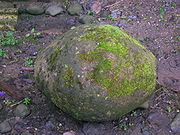 Lying outside in the farm courtyard is a large oval sandstone object with metal attachments on its central axis. This was used to crush whin or gorse in a shallow trough, the stone being dragged up and down by a horse, making the spiny and tough branches of the plant suitable for use as animal feed. It was normally only used when other sources of feed were lacking.
Lying outside in the farm courtyard is a large oval sandstone object with metal attachments on its central axis. This was used to crush whin or gorse in a shallow trough, the stone being dragged up and down by a horse, making the spiny and tough branches of the plant suitable for use as animal feed. It was normally only used when other sources of feed were lacking.

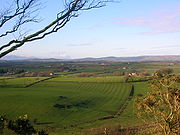 The familiar Rig and furrow
The familiar Rig and furrow
marks in the Buchans field are exceptionally well preserved due to the fact that heavy machinery was rarely used here. These marks represent the way in which earth was built along the centre of a long strip or rig of land with drains or furrows at either side. This is how crops were grown up until the 17th century before enclosure with hedges and fences took place, as well as great social changes, improved farm machinery, etc., all of which altered the way in which fields were ploughed and managed (Blair 1976).
Most of the artefacts recovered are of 19th-century origin. These include white and brown glazed pottery, stoneware, bottle and window glass, porcelain figurines, clay pipes and roof slates. More unusual finds include beads, buttons, burnt bone, lead toy soldiers, medieval green-glaze pottery and flint. Most of these items would probably have come from the 'night soil', which was deposited on the midden and then spread with the manure from the farmyard midden.
and constructed in 1998-2001 on newly purchased land. It is designed to reflect its links with the world of agricultural and nature, with large sliding entrance doors giving access to a wood-clad barn-like building. The other outer walls appear to be 'white-washed' and the lower portion of almost the whole of one side appears to be open to the ground outside, echoing the design of typical barns, cart sheds, etc.
The three main themes to the museum are land, tools and people. Many of the artifacts and equipment originally came from the existing museum at Ingliston
, others came from an operational traditional working farm, as well as items which were donated and some which were specific acquisitions. The displays illustrate how people lived and worked the land in the past, and how this helped shape the countryside which we see today. The museum also includes items which highlight the folklore
aspects of the farming way of life, including a 'cup marked' stone, a collection of charms
and many other display items.
Specifically themed exhibitions include agricultural tools and equipment, clothing, toys, musical instruments, and household items. Amongst the preserved machinery is the reaping machine
invented by Patrick Bell
(1799–1869), the earliest surviving example of an iron plough invented by James Small (1730-1793) and the best collection of combine harvesters in Europe, mostly housed in an area which can be visited upon request.
The High Breck of Rendall Mill is a permanent exhibit. It is the oldest known surviving threshing
mill in the world.
The museum has a large collection of scale and other models from the Highland Society and other sources relating to farm machinery, water wheels, etc.
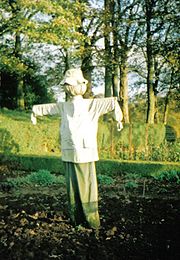
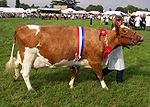 A day at the National Museum of Rural Life gives an opportunity for visitors to get back to the land and experience the traditional way of life as it was on the rural and partly mechanised Scottish farm of the 1950s. Ploughing, sowing
A day at the National Museum of Rural Life gives an opportunity for visitors to get back to the land and experience the traditional way of life as it was on the rural and partly mechanised Scottish farm of the 1950s. Ploughing, sowing
, haymaking and harvesting are all carried out on this working farm. Interpretation guides enable visitors to understand and appreciate the many activities which are part and parcel of the Scottish farming year. Tractor
rides take visitors to the farm where they can also see the herd of pedigree Ayrshire cattle
which calve from January -March being milked every day at 3.00pm and the Kittochside flock of Scottish blackface ewes (sheep) which lamb in early April. 2 new arrivals of Mhairi Mhor and freoch 2 highland cows, along with the resident clydesdale horse and Irish cob. Make the working farm come to life with the sounds and smells of the past, and a warm welcome from the farm staff make for the most enjoyable of days.
An annual programme is offered of demonstrations of country skills, workshops and ranger-guided walks. Activities are spread throughout the year, such as the heavy horse show, the tractor show, the horse shoeing competition, the sheepdog trials, Kittochside Fair, Toytrac Scotland, Christmas at the Farm, the Halloween Party, Willow Harvest, etc.
 Below the Exhibition Building is the glen through which the Kittoch Water runs, previously powering the grain mill which stood on the further bank of the Kittoch Water. The mill cottage still stands and the Weir is visible further up the glen looking towards the road bridge. It had a cast iron wheel, providing a direct link with the MoSRL and its collection of wheelwright's patterns for waterwheels exhibited in the land gallery of the Exhibition Building.
Below the Exhibition Building is the glen through which the Kittoch Water runs, previously powering the grain mill which stood on the further bank of the Kittoch Water. The mill cottage still stands and the Weir is visible further up the glen looking towards the road bridge. It had a cast iron wheel, providing a direct link with the MoSRL and its collection of wheelwright's patterns for waterwheels exhibited in the land gallery of the Exhibition Building.
East Kilbride
East Kilbride is a large suburban town in the South Lanarkshire council area, in the West Central Lowlands of Scotland. Designated as Scotland's first new town in 1947, it forms part of the Greater Glasgow conurbation...
in South Lanarkshire
South Lanarkshire
South Lanarkshire is one of 32 unitary council areas of Scotland, covering the southern part of the former county of Lanarkshire. It borders the south-east of the city of Glasgow and contains many of Glasgow's suburbs, commuter towns and smaller villages....
and the village of Carmunnock
Carmunnock
Carmunnock is a conservation village within the City of Glasgow boundary, lying within three miles of East Kilbride and Rutherglen in South Lanarkshire, and Busby, East Renfrewshire....
in Glasgow
Glasgow
Glasgow is the largest city in Scotland and third most populous in the United Kingdom. The city is situated on the River Clyde in the country's west central lowlands...
.
The Creation of the Museum
The project, opened in 2001, cost over nine million pounds and was made possible through a partnership between the National Museums of Scotland, the National Trust for ScotlandNational Trust for Scotland
The National Trust for Scotland for Places of Historic Interest or Natural Beauty, commonly known as the National Trust for Scotland describes itself as the conservation charity that protects and promotes Scotland's natural and cultural heritage for present and future generations to...
, the Heritage Lottery Fund
Heritage Lottery Fund
The Heritage Lottery Fund is a fund established in the United Kingdom under the National Lottery etc. Act 1993. The Fund opened for applications in 1994. It uses money raised through the National Lottery to transform and sustain the UK’s heritage...
, the European Regional Development Fund
European Regional Development Fund
The European Regional Development Fund is a fund allocated by the European Union.-History:During the 1960s, the European Commission occasionally tried to establish a regional fund. Only Italy ever supported this, however, and nothing came of it. Britain made it an issue for their accession in...
, South Lanarkshire Council, Scottish Natural Heritage
Scottish Natural Heritage
Scottish Natural Heritage is a Scottish public body. It is responsible for Scotland's natural heritage, especially its natural, genetic and scenic diversity. It advises the Scottish Government and acts as a government agent in the delivery of conservation designations, i.e...
and a number of private funders.
The National Museum of Rural Life has greatly extended the work of the former Scottish Agricultural Museum, founded in 1949, latterly located within the Royal Highland Showground
Royal Highland Showground
The Royal Highland Centre is the exhibition centre and showgrounds located at Ingliston west of Edinburgh, Scotland, adjacent to Edinburgh Airport and the A8....
at Ingliston
Ingliston
Ingliston is an area in the west of Edinburgh, Scotland.It is south of Edinburgh Airport and home to the Royal Highland Showground.From 1965 to 1992 motor racing took place at Ingliston Motor Racing circuit, which was located within the Royal Highland Showground.From 1973 to 2005, Ingliston held a...
, west of Edinburgh
Edinburgh
Edinburgh is the capital city of Scotland, the second largest city in Scotland, and the eighth most populous in the United Kingdom. The City of Edinburgh Council governs one of Scotland's 32 local government council areas. The council area includes urban Edinburgh and a rural area...
.
The completed National Museum of Rural Life features a 50000 square feet (4,645.2 m²) museum and visitor centre, the Georgian
Georgian architecture
Georgian architecture is the name given in most English-speaking countries to the set of architectural styles current between 1720 and 1840. It is eponymous for the first four British monarchs of the House of Hanover—George I of Great Britain, George II of Great Britain, George III of the United...
buildings of Wester Kittochside farm, the species-rich fields and hedgerows around it and a 24 ha (60 acre) events area.
The Lairds of Kittochside
The 69 ha (170 acre) farm was gifted in 1992 to the National Trust for Scotland by Mrs. Margaret Reid who had run the farm for many years with her late husband James, the last of ten generations of Reids. The Reids, as Lairds of Kittochside, farmed the property over a period of 400 years from 1567 to 1992.Originally, John Reid, previously the tenant, had purchased the lands of Kittochside in 1567 from the Robert Muir, Laird of Caldwell. Muir tried to take back the lands by force and after burning down Kittochside the case came to be adjudicated at the Privy Council of James VI in 1600, the result being that Robert Muir was jailed for six years and then the Reids were free to develop the farm buildings and lands.
During the covenanting troubles the Reids were prominent and they fought against the king at the Battle of Bothwell Brig in 1679. At one point in the battle the Kilbryd (Kilbride) Parish Flag was taken by the enemy and James Reid fought his way to its rescue, ripping it off its pole and wrapping it around his body as he ran with it. He was captured and would have been sent abroad as a convict if it were not for the intervention of the Duke of Hamilton. James was jailed for a time and then returned in less violent times to manage Wester Kittochside farm.
The Laird's House

Some of the buildings have carved ball finial
Finial
The finial is an architectural device, typically carved in stone and employed decoratively to emphasize the apex of a gable or any of various distinctive ornaments at the top, end, or corner of a building or structure. Smaller finials can be used as a decorative ornament on the ends of curtain rods...
s on the gable ends as per the architectural fashion of the time. The finial can also function as a lightning rod
Lightning rod
A lightning rod or lightning conductor is a metal rod or conductor mounted on top of a building and electrically connected to the ground through a wire, to protect the building in the event of lightning...
, and was once believed to act as a deterrent to witches
Witchcraft
Witchcraft, in historical, anthropological, religious, and mythological contexts, is the alleged use of supernatural or magical powers. A witch is a practitioner of witchcraft...
on broomsticks attempting to land on one's roof. On making her final landing approach to a roof, the witch, spotting the obstructing finial, was forced to sheer off and land elsewhere.
Both the house and the farm stand on an exposed hill top and are screened from the elements by mature trees, a particularly fine old Sycamore or Plane
Sycamore Maple
Acer pseudoplatanus, the sycamore maple, is a species of maple native to central Europe and southwestern Asia, from France east to Ukraine, and south in mountains to northern Spain, northern Turkey, and the Caucasus. It is not related to other trees called sycamore or plane tree in the Platanus...
(Acer pseudoplatanus) being prominent amongst them.
The Farm Buildings
The north and west ranges were built in 1782-4 by John Reid. The north range stands on the foundations of an earlier building, probably a 17th century longhouseLong house
A longhouse or long house is a type of long, proportionately narrow, single-room building built by peoples in various parts of the world including Asia, Europe and North America....
. The small byre was re-roofed and upgraded in the mid 19th and early 20th centuries. The corn barn still has its threshing
Threshing
Threshing is the process of loosening the edible part of cereal grain from the scaly, inedible chaff that surrounds it. It is the step in grain preparation after harvesting and before winnowing, which separates the loosened chaff from the grain...
floor where a flail
Flail (agriculture)
A flail is an agricultural tool used for threshing to separate grains from their husks.It is usually made from two or more large sticks attached by a short chain; one stick is held and swung, causing the other to strike a pile of grain, loosening the husks...
would have been used by hand until a horse-engine and threshing machine was installed in around 1820 to 1840. This was in turn replaced in 1860 by the present threshing mill. Finally around 1870 travelling mills made even this mill redundant.
The 6th Laird was involved in quarrying and limestone-burning, hence the need for a stable with room for three horses and loose box, with a loft above. Various modifications took place over the years and a Dutch barn was built in 1949. Dairying ceased in 1980 and the farm turned to raising beef cattle until 1992 when the National Trust for Scotland took over the running of the farm operations.
The Horse Engine or Gin

Horse mill
A horse mill is a mill that uses a horse as the power source. Any milling process can be powered in this way, but the most frequent use of animal power in horse mills was for grinding grain and pumping water. Other animals used for powering mills include dogs, donkeys and oxen. Engines powered by...
' , engine or 'gin' at Wester Kittochside has been professionally excavated and restored to working condition. It had been used to drive farm machinery, such as the winnowing machine in the corn barn which removes the husk from grain, powered via a rotating horizontal axle drive from the gin. As already stated, prior to using horse driven machines a flail
Flail (agriculture)
A flail is an agricultural tool used for threshing to separate grains from their husks.It is usually made from two or more large sticks attached by a short chain; one stick is held and swung, causing the other to strike a pile of grain, loosening the husks...
was used by the farm workers to separate the grain from the husk. The flail itself being a wood pole with a smaller pole linked at the end via a chain or leather thong. Another door opposite the existing barn door used to provide sufficient wind to separate the grain from the chaff or seed husks.
The Bothy
A single room to house a bachelor farm servant was called a bothyBothy
A bothy is a basic shelter, usually left unlocked and available for anyone to use free of charge. It was also a term for basic accommodation, usually for gardeners or other workers on an estate. Bothies are to be found in remote, mountainous areas of Scotland, northern England, Ireland, and Wales....
. The example at Wester Kittochside was used as a tack room in the early 20th century, but came back into use during the Second World War when it was used as quarters for a German prisoner of war, Heinrich Luckel, who remained in contact with the Reid family for many years after the end of the conflict.
Doocot, Cart and Gig Sheds

Dovecote
A dovecote or dovecot is a structure intended to house pigeons or doves. Dovecotes may be square or circular free-standing structures or built into the end of a house or barn. They generally contain pigeonholes for the birds to nest. Pigeons and doves were an important food source historically in...
or doocot is located above the door of the cart shed building. The doocot is a typical feature of country estates, as the right to build one was strictly limited to the major landowners initially, and only later were small freeholders permitted to build them; at a more recent date tenants could sometimes gain permission from their landlord to build doocots to provide food or to add a picturesque feature to their properties. (Peters 2003). In the Middle Ages doocots or pigeon-houses were a badge of manorial privilege and distinctive, often very ornate buildings were constructed (Buxbaum 1987). The Kittochside doocot is a simple and practical design, however the problem of the pigeons feeding off the farm crops still had to be balanced against the benefits of the all year round meat supply that the doocot provided . A lean-to gig shed, (gig: a light, two-wheeled sprung cart pulled by one horse) was built at the north end of the stable in the early 19th century.
The Stathel

Edinburgh
Edinburgh is the capital city of Scotland, the second largest city in Scotland, and the eighth most populous in the United Kingdom. The City of Edinburgh Council governs one of Scotland's 32 local government council areas. The council area includes urban Edinburgh and a rural area...
. The structure is basically a cast-iron version of a set of staddle stones with its upper wooden framework. These rare survivals are still in use for supporting ricks, keeping the material well aired and dry underfoot, as well as free from rats and mice which cannot run up the legs of the structure and make it 'up and over' the 'mushroom shaped' tops and thence into the hay, etc.
The Whin Stone

Field Names
An interesting survival and a source of historical information, is the record of field names from the 1858 farm map, giving us such names as Buchans, Long Croft, Short Croft, Greenlawford, Fauselands, Queyspark, etc. The meaning of these names are explained in the Laird's House where an exhibition room is dedicated to the history of the Reid family and their farm.The Stile Gateposts
Sandstone 'stile' gateposts are found at the bottom entry point to the Buchans field beside the pedestrian footpath. Such 'stile' gateposts were built with a series of downward facing 'L' shaped grooves on one side and a matching concavity on the other gatepost. Wood bars could then be inserted across and parallel, giving a gate without a hinge. These are sometimes still found in the countryside at large, but they are almost always adapted to carry metal hinged gates. In some areas wood rather than stone was used to construct this type of hinge-less gatepost.Rig and Furrow


Rig and furrow
Rig and furrow was a type of cultivation practised in upland areas of the British Isles which differs from the more common ridge and furrow in that it appears to have been created through excavation by spade rather than plough....
marks in the Buchans field are exceptionally well preserved due to the fact that heavy machinery was rarely used here. These marks represent the way in which earth was built along the centre of a long strip or rig of land with drains or furrows at either side. This is how crops were grown up until the 17th century before enclosure with hedges and fences took place, as well as great social changes, improved farm machinery, etc., all of which altered the way in which fields were ploughed and managed (Blair 1976).
Archaeology
As part of Scottish Archaeology Month in September 2005, 50 volunteers took part in a fieldwalking exercise to the SW of Wester Kittochside Farm (NS65NW 72). An area of 110 x 20 m was gridded out in 10 m squares, and the volunteers spent 5 minutes in each grid collecting all the visible artefacts.Most of the artefacts recovered are of 19th-century origin. These include white and brown glazed pottery, stoneware, bottle and window glass, porcelain figurines, clay pipes and roof slates. More unusual finds include beads, buttons, burnt bone, lead toy soldiers, medieval green-glaze pottery and flint. Most of these items would probably have come from the 'night soil', which was deposited on the midden and then spread with the manure from the farmyard midden.
The Exhibition Building and the Collections
The Exhibition Building was designed by Page\Park ArchitectsPage\Park Architects
Page\Park Architects was established in 1981 by David Page and Brian Park and has developed as one of Scotland’s best known practices undertaking work over a range of sectors....
and constructed in 1998-2001 on newly purchased land. It is designed to reflect its links with the world of agricultural and nature, with large sliding entrance doors giving access to a wood-clad barn-like building. The other outer walls appear to be 'white-washed' and the lower portion of almost the whole of one side appears to be open to the ground outside, echoing the design of typical barns, cart sheds, etc.
The three main themes to the museum are land, tools and people. Many of the artifacts and equipment originally came from the existing museum at Ingliston
Ingliston
Ingliston is an area in the west of Edinburgh, Scotland.It is south of Edinburgh Airport and home to the Royal Highland Showground.From 1965 to 1992 motor racing took place at Ingliston Motor Racing circuit, which was located within the Royal Highland Showground.From 1973 to 2005, Ingliston held a...
, others came from an operational traditional working farm, as well as items which were donated and some which were specific acquisitions. The displays illustrate how people lived and worked the land in the past, and how this helped shape the countryside which we see today. The museum also includes items which highlight the folklore
Folklore
Folklore consists of legends, music, oral history, proverbs, jokes, popular beliefs, fairy tales and customs that are the traditions of a culture, subculture, or group. It is also the set of practices through which those expressive genres are shared. The study of folklore is sometimes called...
aspects of the farming way of life, including a 'cup marked' stone, a collection of charms
Amulet
An amulet, similar to a talisman , is any object intended to bring good luck or protection to its owner.Potential amulets include gems, especially engraved gems, statues, coins, drawings, pendants, rings, plants and animals; even words said in certain occasions—for example: vade retro satana—, to...
and many other display items.
Specifically themed exhibitions include agricultural tools and equipment, clothing, toys, musical instruments, and household items. Amongst the preserved machinery is the reaping machine
Reaper
A reaper is a person or machine that reaps crops at harvest, when they are ripe.-Hand reaping:Hand reaping is done by various means, including plucking the ears of grains directly by hand, cutting the grain stalks with a sickle, cutting them with a scythe, or with a later type of scythe called a...
invented by Patrick Bell
Patrick Bell
Rev Patrick Bell was a Church of Scotland minister and inventor.-Biography:Born in the rural parish of Auchterhouse in Angus, Scotland, into a farming family, Bell chose to study divinity at the University of St Andrews...
(1799–1869), the earliest surviving example of an iron plough invented by James Small (1730-1793) and the best collection of combine harvesters in Europe, mostly housed in an area which can be visited upon request.
The High Breck of Rendall Mill is a permanent exhibit. It is the oldest known surviving threshing
Threshing
Threshing is the process of loosening the edible part of cereal grain from the scaly, inedible chaff that surrounds it. It is the step in grain preparation after harvesting and before winnowing, which separates the loosened chaff from the grain...
mill in the world.
The museum has a large collection of scale and other models from the Highland Society and other sources relating to farm machinery, water wheels, etc.
The Visitor Experience


Sowing
Sowing is the process of planting seeds.-Plants which are usually sown:Among the major field crops, oats, wheat, and rye are sowed, grasses and legumes are seeded, and maize and soybeans are planted...
, haymaking and harvesting are all carried out on this working farm. Interpretation guides enable visitors to understand and appreciate the many activities which are part and parcel of the Scottish farming year. Tractor
Tractor
A tractor is a vehicle specifically designed to deliver a high tractive effort at slow speeds, for the purposes of hauling a trailer or machinery used in agriculture or construction...
rides take visitors to the farm where they can also see the herd of pedigree Ayrshire cattle
Ayrshire cattle
The Ayrshire cattle is a breed of dairy cattle originated from Ayrshire in Scotland. The average mature Ayrshire cow weighs 1,000-1,300 pounds . Ayrshires have red markings. The red can be an orange to a dark brown, with or without coloured legs. They are known for low somatic cell counts,...
which calve from January -March being milked every day at 3.00pm and the Kittochside flock of Scottish blackface ewes (sheep) which lamb in early April. 2 new arrivals of Mhairi Mhor and freoch 2 highland cows, along with the resident clydesdale horse and Irish cob. Make the working farm come to life with the sounds and smells of the past, and a warm welcome from the farm staff make for the most enjoyable of days.
An annual programme is offered of demonstrations of country skills, workshops and ranger-guided walks. Activities are spread throughout the year, such as the heavy horse show, the tractor show, the horse shoeing competition, the sheepdog trials, Kittochside Fair, Toytrac Scotland, Christmas at the Farm, the Halloween Party, Willow Harvest, etc.
Kittochglen and Philipshill Mill

Education
The museum provides a national educational resource on countryside practices, biodiversity, the environment, traditional and more recent farming methods involving pesticides and fertilisers, topical issues, etc. It focuses on the long history of agriculture in Scotland and on the lives of those who lived and worked in the countryside.See also
- Dalgarven MillDalgarven MillDalgarven Mill is near Kilwinning, in the Garnock Valley, North Ayrshire, Scotland and it is home to the Museum of Ayrshire Country Life and Costume. The watermill has been completely restored over a number of years and is run by the independent Dalgarven Mill Trust.The village of Dalgarven was...
The Ayrshire Museum of Country Life and Costume. - Staddle stonesStaddle stonesStaddle stones were originally used as supporting bases for granaries, hayricks, game larders, etc. The staddle stones lifted the granaries above the ground thereby protecting the stored grain from vermin and water seepage...
- Painted pebblesPainted pebblesPainted pebbles are a class of Pictish artifact unique to northern Scotland in the first millennium AD.- Appearance :They are small rounded beach pebbles made of quartzite, which have been painted with simple designs in a dye which is now dark brown in colour. The size varies from 18 mm by...
- DovecoteDovecoteA dovecote or dovecot is a structure intended to house pigeons or doves. Dovecotes may be square or circular free-standing structures or built into the end of a house or barn. They generally contain pigeonholes for the birds to nest. Pigeons and doves were an important food source historically in...
- FarmFarmA farm is an area of land, or, for aquaculture, lake, river or sea, including various structures, devoted primarily to the practice of producing and managing food , fibres and, increasingly, fuel. It is the basic production facility in food production. Farms may be owned and operated by a single...
- GorseGorseGorse, furze, furse or whin is a genus of about 20 plant species of thorny evergreen shrubs in the subfamily Faboideae of the pea family Fabaceae, native to western Europe and northwest Africa, with the majority of species in Iberia.Gorse is closely related to the brooms, and like them, has green...
- Dunlop cheeseDunlop cheeseDunlop is a mild cheese or 'sweet-milk cheese' from Dunlop in East Ayrshire, Scotland. It resembles a soft Cheddar cheese in texture. It fell out of popularity some time after the end of the Second World War, however it has now appreciated for its value in various recipes and for eating on its own...
- GatepostGatepostA gatepost is a structure used to support gates or crossbars which control entry to an area, such as a field or driveway.- Purpose :If the gatepost is utilitarian in purpose then gateposts will be made as strictly functional structures; however as part of the 'advertisement' of the status of the...
- Royal Commission on the Ancient and Historical Monuments of ScotlandRoyal Commission on the Ancient and Historical Monuments of ScotlandThe Royal Commission on the Ancient and Historical Monuments of Scotland is an executive non-departmental public body of the Scottish Government 'sponsored' [financed and with oversight] through Historic Scotland, an executive agency of the Scottish Government...
- A Researcher's Guide to Local History terminology

